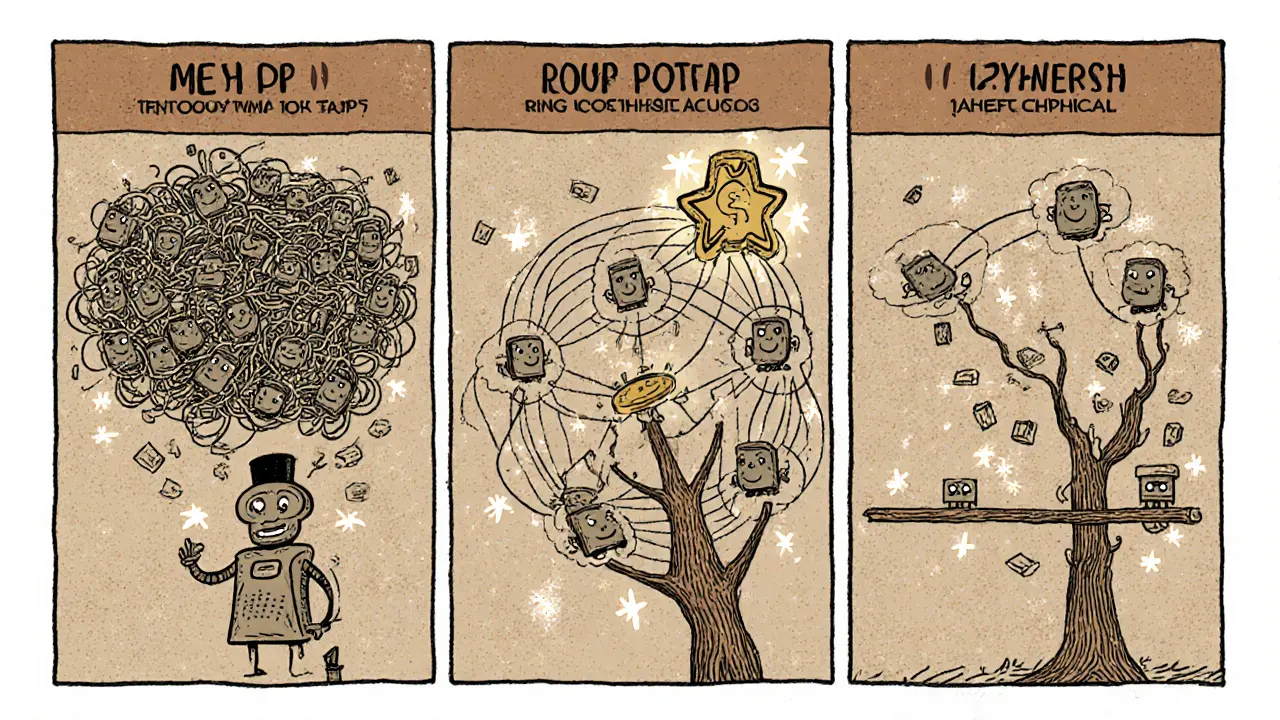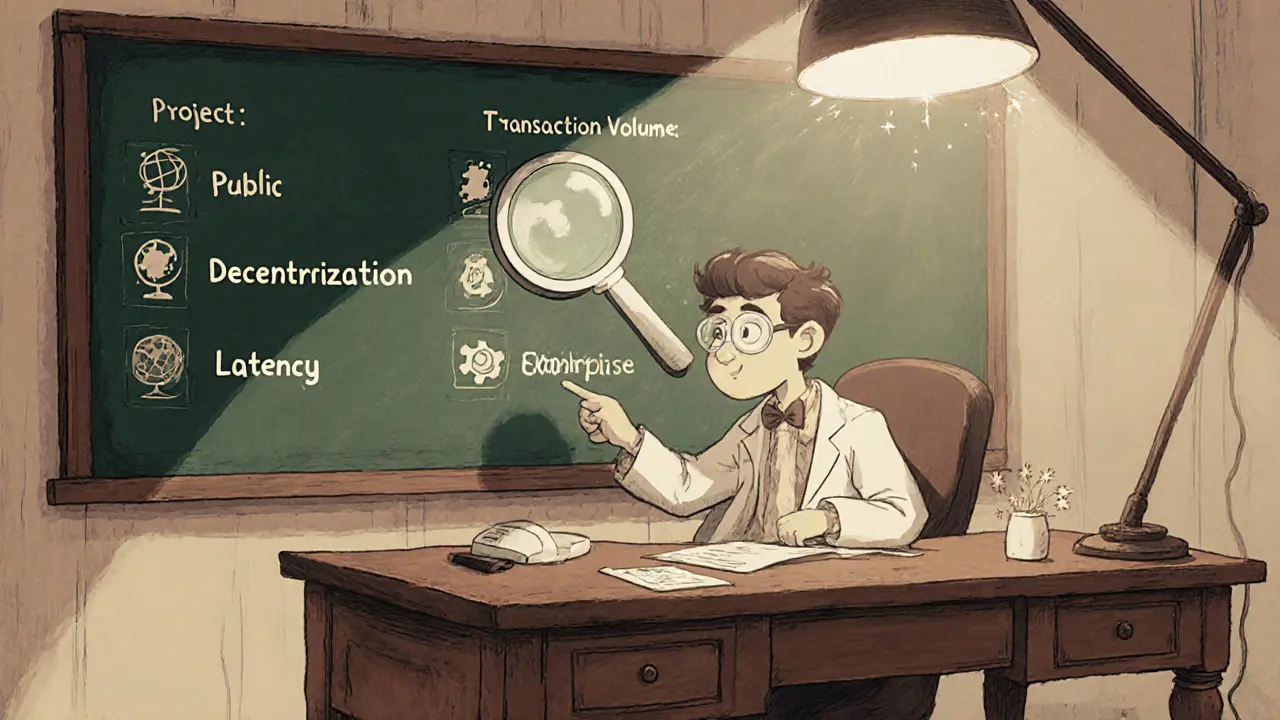Blockchain Network Topology Selector
Topology Comparison Chart
| Topology | Decentralization | Scalability | Typical Use Case |
|---|---|---|---|
| Mesh (P2P) | High | Medium-High | Public cryptocurrencies |
| Router (Star) | Low-Medium | High | Consortiums, private ledgers |
| Ring | Medium | Medium | IoT clusters, low-bandwidth nets |
| Tree (Hierarchical) | Medium-High | High | Enterprise supply-chain, federated data |
| Bus | Low | Low-Medium | Legacy internal systems |
Quick Overview
- Network topology defines how blockchain nodes connect and share data.
- Peer-to-peer (mesh) topology offers the highest decentralization.
- Router (star) and ring topologies trade off scalability for simpler management.
- Choosing a topology impacts latency, security, and transaction throughput.
- Modern research focuses on hybrid designs that keep decentralization while boosting performance.
What Is blockchain network topology?
In the simplest terms, Blockchain network topology is the pattern of connections among all nodes that participate in a blockchain system. Those nodes can be full nodes, miners, validators, or lightweight clients. The way they link together decides how fast a new transaction or block spreads, how resilient the network is to attacks, and how easily the system can grow.
Every blockchain runs on a peer-to-peer (P2P) protocol stack. When you send a transaction, your node packages it, signs it, and pushes it to a handful of peers. Those peers rebroadcast it to their neighbors, creating a ripple that reaches thousands of nodes within seconds. This broadcast behavior is a direct consequence of the underlying topology.
Core Topology Models
Researchers and practitioners usually group blockchain topologies into a handful of classic network designs. Below are the most common ones, each with a concise definition and typical characteristics.
Peer-to-Peer (Mesh) Topology
Mesh topology is a decentralized structure where each node maintains connections to multiple random peers, forming a dense, flat network graph. Bitcoin and early Ethereum implementations use this model. Because data has many possible routes, a single node failure rarely disrupts the whole system.
Router (Star) Topology
Router topology is a hub‑and‑spoke arrangement where all blockchains connect through a central router node. Think of it as a private consortium that funnels all ledger updates through a master server. While management is simple, the central router becomes a critical point of failure.
Ring (Strongly Connected) Topology
Ring topology is a circular layout where each node links only to its immediate neighbors, creating a single closed loop of data flow. This design spreads load evenly but can suffer from higher latency because messages may travel around the entire ring before reaching distant nodes.
Hierarchical (Tree) Topology
Tree topology is a layered structure with a root node and branching sub‑networks, similar to an organizational chart. It can improve routing efficiency for permissioned networks, yet the root node introduces a potential single‑point weakness.
Bus Topology
Bus topology is a simple backbone where all nodes tap into a single communication cable or channel. It’s rarely used in public blockchains because the backbone can become a bottleneck and is vulnerable to disruptions.
How Topology Shapes Performance, Security, and Scalability
Every topology brings a distinct trade‑off matrix. Below is a quick mental model:
- Latency: Mesh networks often achieve the lowest latency because multiple paths exist. Ring and bus topologies may need to wait for data to travel through several hops.
- Throughput: Hierarchical designs can scale horizontally by adding sub‑trees, but the root can cap total transactions per second (TPS). Mesh spreads load, but each node must process many connections, which can strain resources.
- Security: Decentralized topologies make DoS attacks harder-an attacker must compromise many nodes. Centralized router or tree roots become lucrative targets.
- Fault tolerance: In a mesh, losing 10% of nodes rarely affects the overall network. In a bus, a single cable break can halt all traffic.
Consensus mechanisms interact with topology, too. Proof‑of‑Work (PoW) networks like Bitcoin rely on rapid block propagation; a well‑connected mesh minimizes orphaned blocks. Proof‑of‑Stake (PoS) systems such as Ethereum’s Gasper can tolerate slightly higher latency because validators are selected based on stake, not mining competition.

Choosing the Right Topology for Your Project
When you start a blockchain project, ask yourself these practical questions:
- Is decentralization a core value, or can you accept a trusted hub?
- What transaction volume do you anticipate? (Low (<10TPS), medium (10‑100TPS), high (>100TPS))
- Do you need fast finality (seconds) or can you tolerate minutes?
- What are your hardware and bandwidth constraints for participating nodes?
Based on the answers, you can map to a topology:
- Public, permissionless token → Mesh (peer‑to‑peer) for maximum decentralization.
- Consortium of banks → Hierarchical or router topology, because known participants simplify governance.
- IoT network with limited bandwidth → Ring topology can limit neighbour connections, saving bandwidth.
- Enterprise supply‑chain solution → Tree topology with regional gateways for efficient routing.
Current Trends and Research Directions
2024‑2025 saw a surge in hybrid topologies that blend the resilience of mesh with the efficiency of hierarchical routing. Notable projects include:
- Polkadot’s relay chain - uses a core hub (router) plus parachains that form mini‑meshes.
- Celestia - separates consensus from data availability, allowing lightweight nodes to connect in a partial mesh.
- Hyperledger Fabric - lets organizations define custom channel topologies, effectively creating dynamic bus‑like sub‑networks for private data.
Academic papers are also exploring “strongly connected” models that guarantee at least two disjoint paths between any two nodes, reducing the risk of partition attacks. Simulation results show up to a 30% reduction in block propagation latency compared to a pure random mesh.
Troubleshooting Common Topology Issues
Even a well‑designed network can stumble. Here are quick fixes for typical problems:
- Node churn causing slow sync - Increase peer‑discovery interval and add stable bootstrap nodes.
- Bandwidth saturation in mesh - Enable outbound connection limits (e.g., max 8 peers per node) and use gossip compression.
- Single‑point failure in router topology - Deploy a hot‑standby router and enable automatic fail‑over.
- Ring latency spikes - Insert additional shortcut links (small‑world edges) to create shortcuts across the ring.
- Tree root overload - Partition the tree into multiple forests with federation protocols.
Comparison of Popular Topologies
| Topology | Decentralization | Scalability | Typical Use‑Case | Pros | Cons |
|---|---|---|---|---|---|
| Mesh (P2P) | High | Medium‑High (depends on node count) | Public cryptocurrencies | Resilient, fast propagation | Resource‑intensive for peers |
| Router (Star) | Low‑Medium | High (central node can scale vertically) | Consortiums, private ledgers | Simple management, predictable latency | Single‑point failure, target for attacks |
| Ring (Strongly Connected) | Medium | Medium (linear growth) | IoT clusters, low‑bandwidth nets | Even load distribution | Higher latency, vulnerability to break in the loop |
| Tree (Hierarchical) | Medium‑High (depends on depth) | High (adds branches) | Enterprise supply‑chain, federated data | Efficient routing, clear governance | Root node risk, possible bottlenecks |
| Bus | Low | Low‑Medium | Legacy internal systems | Simple wiring | Backbone failure stops everything |
Next Steps for Builders
1. Map your desired decentralization level to one of the topologies above.
2. Prototype a small testnet using the chosen network layer (e.g., libp2p for mesh, custom hub for router).
3. Run latency and throughput benchmarks with realistic node counts.
4. Iterate - add shortcut peers or secondary hubs if you hit performance limits.
5. Document your topology decisions; future auditors will ask why you chose that structure.

Frequently Asked Questions
What makes a mesh topology more secure than a star topology?
In a mesh, an attacker must compromise many independent nodes to disrupt the network, whereas a star relies on a single hub. That hub being down or taken over can cripple the entire system.
Can I switch from a tree topology to a mesh after launch?
Yes, but it requires a network upgrade: add peer‑discovery protocols, re‑configure node connections, and potentially rewrite the consensus layer to handle more gossip traffic.
How does topology affect block propagation time?
More connected topologies (mesh) provide multiple parallel paths, so a new block reaches most nodes in under a second. Simpler topologies like a bus or ring may need several hops, adding milliseconds to each hop.
Is a router topology ever appropriate for a public blockchain?
Generally not, because it contradicts the core principle of decentralization. However, some permissioned public‑like networks use a trusted hub for regulatory compliance while still offering limited openness.
What tools can I use to visualize my blockchain’s topology?
Open‑source tools such as libp2p‑graph, Netdata, or custom Grafana dashboards with node‑to‑node metrics can render live topology maps. For permissioned setups, Hyperledger Explorer also offers topology diagrams.


Matt Nguyen
October 26, 2024 AT 17:56When you peer beneath the veneer of blockchain topologies, you encounter an elegant hierarchy of connectivity that most novices overlook. The mesh, router, ring, tree, and bus configurations each bear distinct trade‑offs, akin to the gears of a finely tuned watch. It is incumbent upon the architect to align decentralization aspirations with scalability constraints. Ignoring these nuances is tantamount to building a cathedral on sand.
Katherine Sparks
October 29, 2024 AT 01:29Thank you for this comprehensive overview; it clarifies many of the choices we developers face. Your breakdown of latency versus fault tolerance is especially helpful. 😊
Kimberly Kempken
October 31, 2024 AT 09:03Honestly, this guide sounds like a corporate PR piece masquerading as technical content. You gloss over the fact that most topologies are just theoretical fantasies for hobbyists. If you truly cared, you'd expose the hidden power dynamics behind "decentralization".
Kortney Williams
November 2, 2024 AT 16:36I appreciate the balanced tone here; the explanation of tree hierarchy resonated with my supply‑chain project. The way you tied governance to the root node was clear and useful. It gives a solid starting point for further reading.
Laurie Kathiari
November 5, 2024 AT 00:09While the prior comment tries to sound edgy, the reality is that most of these topologies are oversold by vendors. Mesh networks may sound democratic, but they devour bandwidth like a ravenous beast. A router‑centric design, though less trendy, often delivers the reliability enterprises actually need.
Promise Usoh
November 7, 2024 AT 07:43From a philosophical standpoint, the choice of topology mirrors the underlying governance philosophy of a blockchain. A highly decentralized mesh aligns with libertarian ideals, whereas a hierarchical tree reflects a more paternalistic approach. It is worth pondering how these structural decisions echo broader societal values.
Amal Al.
November 9, 2024 AT 15:16Great article! I would add that for emerging markets, the bandwidth constraints often dictate a ring topology because it limits peer connections. Additionally, over‑punctuation can sometimes obscure clarity-so keep it simple. Let’s keep the discussion focused on practical trade‑offs.
Natalie Rawley
November 11, 2024 AT 22:49Wow, this is basically the *Bible* of blockchain networking! I mean, who knew a bus could still be relevant? The drama of picking the right topology is almost as thrilling as a TV finale.
Scott McReynolds
November 14, 2024 AT 06:23Let me take a moment to unpack the myriad implications of topology selection for blockchain engineers. First, the mesh topology grants maximal redundancy, ensuring that even if several nodes drop offline, the gossip protocol still propagates blocks efficiently. Second, the router (star) design centralizes traffic, which can lead to predictable latency but also creates a single point of failure that attackers love to exploit. Third, the ring configuration, while elegant in its simplicity, suffers from linear propagation delays, making it less suitable for high‑throughput environments. Fourth, hierarchical trees provide an intuitive way to segment large networks into regional clusters, yet their root nodes become attractive bottlenecks that must be hardened against DDoS attacks. Fifth, the bus topology, though archaic, can be useful for small, tightly‑controlled deployments where a shared medium simplifies troubleshooting. Moreover, modern hybrid approaches attempt to combine the resilience of mesh with the efficiency of hierarchical routing, often by adding shortcut links that create small‑world networks. These shortcuts dramatically reduce the diameter of the graph, cutting block propagation times by up to 30 % in simulations. Another critical factor is consensus algorithm compatibility: Proof‑of‑Work systems demand low latency to minimize orphaned blocks, whereas Proof‑of‑Stake can tolerate slightly higher latencies thanks to validator selection mechanisms. Additionally, node hardware constraints play a huge role; low‑power IoT devices benefit from ring or bus topologies that limit the number of connections they must maintain. Finally, when scaling from a handful of nodes to thousands, you must continuously monitor peer churn, bandwidth saturation, and the emergence of network partitions, adjusting the topology dynamically if needed. In summary, there is no one‑size‑fits‑all solution; each topology offers a unique blend of decentralization, scalability, security, and operational overhead, and the optimal choice hinges on the specific goals and constraints of your blockchain project.
Alex Gatti
November 16, 2024 AT 13:56Interesting points in the long post i wonder how many people actually test hybrid designs in production it seems like a lot of theory
John Corey Turner
November 18, 2024 AT 21:29The colorful analogy of blockchain topologies to watch gears really paints a vivid picture. It's a neat way to convey complexity without jargon overload. Keep the metaphors coming!
Jenise Williams-Green
November 21, 2024 AT 05:03One cannot ignore the moral dimension hidden within these architectural choices; opting for a mesh is a declaration of trust in the crowd, whereas a star betrays a subtle authoritarian bent. The author’s crisp prose highlights this tension with dramatic flair. Such reflections elevate the discussion beyond mere technicalities.
Adarsh Menon
November 23, 2024 AT 12:36Sure, the guide says "bus is simple" but seriously, who even uses a bus nowadays? It's like preaching vinyl in the age of streaming. The write‑up could use a reality check.
Jim Griffiths
November 25, 2024 AT 20:09Practical tip: start with a small mesh testnet and measure propagation latency. Then decide if you need a hybrid.
Rob Watts
November 28, 2024 AT 03:43Great guide. Keep it simple.
Bhagwat Sen
November 30, 2024 AT 11:16Nice breakdown! I’ll try a hybrid on my next project.
Cathy Ruff
December 2, 2024 AT 18:49This is basically a marketing fluff piece. Skip it.
Amy Harrison
December 5, 2024 AT 02:23Loved the clarity! 🚀
mukesh chy
December 7, 2024 AT 09:56Sure, topologies matter, but you’re not changing the fact that blockchains are overhyped.
Marc Addington
December 9, 2024 AT 17:29Decentralization is a myth if you rely on a central hub.
Lurline Wiese
December 12, 2024 AT 01:03This post reads like a drama script, but at least it’s entertaining.
Cynthia Rice
December 14, 2024 AT 08:36Topology choice is context‑dependent; no universal answer.
Eva Lee
December 16, 2024 AT 16:09The inclusion of jargon‑heavy sections may alienate newcomers, yet it provides depth for seasoned engineers.
stephanie lauman
December 18, 2024 AT 23:43Well‑structured and thorough-exactly what the community needs. 😊
Twinkle Shop
December 21, 2024 AT 07:16This guide is a solid foundation for blockchain architects.
Greer Pitts
December 23, 2024 AT 14:49Nice work, really helpful for folks just starting out. The examples are clear.
Shaian Rawlins
December 25, 2024 AT 22:23I found the discussion on hybrid topologies particularly enlightening; it bridges the gap between theoretical resilience and practical deployment concerns. Your emphasis on measuring real‑world latency before committing to a design is spot on. It reminds me of the iterative approach we use in distributed systems engineering, where we prototype, benchmark, and then refine. Overall, the article strikes a good balance between depth and accessibility, making it a valuable resource for both newcomers and seasoned practitioners.
Tyrone Tubero
December 28, 2024 AT 05:56Honestly, the piece feels a bit pretentious, but the core ideas are solid. It’s a decent read for anyone dabbling in blockchain networking.
Taylor Gibbs
December 30, 2024 AT 13:29Thanks for sharing this guide; it’s a great starting point for anyone looking to design a blockchain network. I’ll definitely reference it in my upcoming workshop.